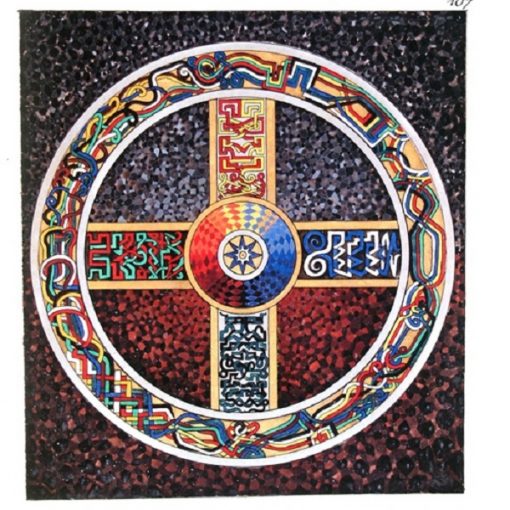
This paper explores varieties of spiritual emergency as a process of profound psychospiritual transformation.
“I’ll be talking about myself! I’ll probably go mad after giving this paper.”1 This refrain went round and round in his head. The paper was on the ‘Importance of the Unconscious in Psychopathology’. The year was 1914. World War I was about to break out. Carl Jung was preparing to give a lecture in Aberdeen, Scotland, invited by the British Medical Association.
Over the next few years, as Europe descended into the madness of war, Jung did indeed plunge into inner chaos. Although he never lost touch with day to day reality, his hold on it was at times tenuous. It was only carrying on working and the knowledge that he had a wife and five children, that he lived at 228 Seestrasse in Küsnacht, which assured him that the material world, and himself in it, was real and existed. He found himself incapable of reading a scientific book for three years.2
As Jung journeyed inwards, exploring his inner world and facing his fear of going mad, he kept detailed journals. He set aside time each day, using a technique of active imagination, consciously entering another realm, in what can perhaps best be described as a Jungian version of Shamanic journeying. The notes he kept resulted in his extraordinary autobiographical Red Book, which he worked on over a 14 year period.
The Red Book was only published in 2009, some 50 years after Jung’s death. In his lifetime he feared it would be misconstrued, taken as the rantings of a madman. Today, his book can be read and understood by the discerning as one person’s process of psychospiritual crisis and awakening. Jung’s account is probably the most detailed, publicly available record we have of what it is like to go through spiritual emergency, although he himself did not use that term. It was only coined later, in the 1980s, by Stanislav and Christina Grof. We can, however, trace the phenomenon of spiritual emergence and emergency back, all the way to the Buddha and Jesus, and beyond.
Understanding Spiritual Emergency
Spiritual emergency is a process of profound psychospiritual transformation. It is a process of healing and growth, of spiritual awakening, which nevertheless is incredibly intense and difficult to manage. Because it impacts on every level of our being, physically, mentally, emotionally and spiritually, it can be totally overwhelming. Many end up on psychiatric wards, partly because our society has so few places where a person can be held and supported through these extreme experiences, and partly because our society tends to interpret psychological crisis as illness, failing to recognise the spiritual dimension. It was precisely because Jung feared the response of those in his field and beyond, that he was wary of publishing his Red Book.
That Jung contributed so much to the field of transpersonal psychology3 and to our understanding of the deeply transformative process of spiritual emergency, is undoubtedly because he went through the process himself. He tells us that all his subsequent work, in effect his life’s accomplishment, stems from that period, from that ‘numinous beginning’. And we know that he considered the awakening of consciousness to be the most important thing we can dedicate ourselves, our lives, to. Man’s task, man’s destiny, Jung tells us, is to “create more and more consciousness”.4
Of particular value to our understanding of the psyche’s workings is his emphasis on the symbolic, the mythological, the non-rational and all that does not make sense to our logical, left brains. He came to understand, during his crisis, through his own encounters with the mythical and the metaphorical, that this is the language of the soul and the psyche; this is how they communicate, how they heal. A perfect example of these archetypal forces coming into play during spiritual emergency is the experience of ‘Kate’ as she grappled with a profound and lengthy dark night of the soul:
“Unaware of the Greek myth of Persephone, I developed a mysterious obsession with pomegranates from the corner shop next to my lodgings and was eating one a day. As the urge to consume the blood-red seeds Persephone ate before her abduction by Hades faded, the narrow doorway to the Underworld shut behind me.”
We can follow a distinguished lineage of transpersonal thinkers down from Jung. All worked, as he did, with clients and patients, their research therefore being informed by clinical practice.
Psychosynthesis: Explaining Grandiosty
Roberto Assagioli, the founder of Psychosynthesis, a transpersonal psychotherapy, was a contemporary of Jung. He too has contributed enormously to our understanding of spiritual emergence and emergency. Worth highlighting is his analysis of why someone going through spiritual emergency may sound grandiose, believing themselves to be, for example, the reincarnation of the Buddha or Christ.
Assagioli explains how the ego appropriates to itself the powerful spiritual energy that is coming through, confusing the higher, spiritual Self with the egoic, personal self. As the personal self experiences the spiritual Self, the individual has a sense of greatness and expansion,and feels as if they are part of divine nature. It is not that we are Jesus, for example, but that we are experiencing the energy of the Christ Consciousness. The ego and the mind are not used to such extraordinary events and get confused. So whilst:
…the inflowing spiritual energies may have the unfortunate effect of feeding and inflating the personal ego…instances of such confusion…are not uncommon among people dazzled by contact with truths which are too powerful for their mental capacities to grasp and assimilate. – Assagioli 5
To dismiss such experiences as ‘delusions of grandeur’ is a great shame, given that something highly significant is likely to be happening for the individual. David Shayler is the ex-MI5 agent who revealed to the press that MI5 had been investigating Labour Government Ministers. A decade later, when he declared himself the reincarnation of the Messiah, he had actually been going through a powerful process of spiritual emergence which tipped over into emergency.
Perry and Diabasis
Another significant player in the transpersonal lineage is J.W. Perry, the American psychiatrist and psychotherapist. He carried out research into alternative residential settings for in-patients, setting up Diabasis in San Francisco in the mid 1970s. This alternative crisis home had facilities such as an art room and a ‘rage room’, equipped with mattresses where people could thrash about safely and vent their feelings. One of the main distinguishing features of Diabasis was that many of the staff had personal experience of extreme or nonordinary states of consciousness, rather than necessarily being traditionally trained mental health staff. The advantage of such personnel is that they will value the extreme and challenging aspect of the person’s experience.
Perry, rather than ignoring patients’ non-rational talk, listened for the psyche’s deeper concerns. He understood the importance of ‘the unconscious’s non-rational system of meaning and values’, much as Jung before him had rated its apparently irrational content. ‘The disadvantage of the nonrational systems is that they are not granted recognition and validation by our culture…’6 Perry’s clinical practice led him to conclude that very often a person’s first acute ‘psychotic’ episode was:
nature’s way of healing a restricted emotional development and of liberating certain vitally needed functions – in short, a spiritual awakening.7
What Perry found at Diabasis was that if you validate the person’s experience and support it in the right way, giving people a positive message about what they are going through, even very ‘psychotic’ clients will ‘usually come into a coherent and reality-oriented state spontaneously within two to six days’.8 Moving through such extreme states of consciousness or spiritual emergencies to a place of integration then took six to eight weeks on average. In his book Trials of the Visionary Mind: Spiritual Emergency and the Renewal Process there is a research report on Diabasis (Appendix C).

Different Types of Spiritual Emergency
Following in the transpersonal lineage, contemporary figures such as Stanislav Grof and his wife Christina have greatly enhanced our understanding of spiritual emergency. In their research the Grofs identified a typology, a classification of the different types of spiritual emergency they found. This included, amongst others, Kundalini awakening 9, near-death experiences, past-life memories and spirit attachment. These various types of spiritual emergency can most usefully be seen as the differing elements that may combine in any one individual experience. So a person going through Kundalini awakening may also have past-life material coming to the surface that needs attention and healing.
In the 20 plus years since the Grofs first published, much research has been carried out into these aspects of spiritual crisis. This has served to strengthen the scientific validity and credibility of the field of spiritual emergency, as there is now a considerable body of evidence supporting our understanding of near-death experiences, past-life memories and more.
Thus, for example, some of the most fascinating and reliable past-life evidence has come from researchers such as Dr. Ian Stevenson 10 and Dr. Jim Tucker 11. Their work has focused on children’s past-life memories. In many instances it has been possible to verify facts reported by children about their previous lives. The University of Virginia holds an astonishing archive and database of 1000s of accounts.
Spirit Attachment: a Brazilian Approach
Spirit attachment can range from a person being scarcely affected, to, in rare instances, the individual’s mind and body being taken over completely. Symptoms can include lack of energy, memory disturbance, behavioural change, mood change, addictive behavior, relationship problems and hearing disturbing voices.12
For solid research in the field of spirit attachment and release,as well as examples of psychiatric good practice,we can look to Brazil. The Spiritist movement,based on the work of Frenchman Allan Kardec, has given rise to over 6,500 Spiritist Centres throughout the country and to a Spiritist approach to relieving mental distress. Spiritism combines Shamanic spirituality with the Christian faith, thanks to the particular cultural and ethnic mix of Brazil. It brings together elements from esoteric traditions, such as spirit communication through mediums; Christian beliefs, Indian philosophy on reincarnation and karma, along with the modern science of parapsychology, metaphysics, the new physics and the study of energy healing.
Historically, Spiritism in Brazil has grown up with a strong academic and research element. Papers presented by Brazilian academics and medics at the Second British Congress on Medicine and Spirituality (2009)13 included the Neuroscience of Mediumship and Depression, Bipolar Disorder and Spiritual Disturbances.
One Spiritist Centre stands out, in Palmelo, which includes a psychiatric hospital. Run on Spiritist principles, treatment combines energy passes by healer mediums to help with spirit release, with Western psychiatric approaches, such as occupational therapy and medication. In 1997 the Centre was recognized by UNESCO (United Nations Educational, Scientific and Cultural Organization) as an asset serving all of humanity.
Emma Bragdon, an authority on spiritual emergency 14, gives a case study in her book Kardec’s Spiritism 15. It involves Marcel, a young man who was diagnosed with schizophrenia. He experienced crabs and spiders crawling all over him and mood swings, including at times turning aggressive. He was told he would have to manage his symptoms with strong medication for the rest of his life, despite the medication making him feel unwell.
Marcel then spent about three months at the Spiritist psychiatric hospital in Palmelo, where he received regular energy healing alongside mainstream treatment. It became apparent to the mediums treating him that he was being troubled by spirit entities, who had known him in past lives. The energy passes he received helped to clear the spirit attachments and he went on to make a full recovery.
Mainstream Psychiatry
Marie Moore was not so fortunate. She was plagued by visions of being buried alive, burned at the stake and gassed. These are typical of past-life trauma and it is likely that some, if not all the scenes tormenting Marie were pastlife related. Tragically, this was not picked up on by mental health services or those around her. In her distress she shot dead first her son and then herself at a firing range in Florida in 2009.
Is psychiatry cautiously and hesitatingly beginning to embrace the transpersonal? Whilst we are a long way from mainstream services taking on board issues such as pastlives or spirit attachment,there are tentative signs that some are beginning to pay attention. John Nelson, the American psychiatrist,suggests in his textbook Healing the Split,16 that nonphysical entities taking up residence in a person’s psyche could explain multiple personality disorder and the UK Royal College of Psychiatrists’ Spirituality and Psychiatry Special Interest Group has run a day-long programme on ‘Minds within Minds: the case for Spirit Release Therapy’.
Supporting Spiritual Emergency
Fortunately, therapeutic approaches have developed alongside research not only in Brazil. In the UK, the Spirit Release Foundation, set up by psychiatrist Dr. Alan Sanderson is active in training spirit release therapists. Also Dr. Roger Woolger, Jungian analyst, regression therapist and author, trained therapists, both in the UK and internationally in Deep Memory Process therapy. This helps people release and heal trauma from past lives. Not surprisingly, Woolger worked a great deal in Brazil. Other transpersonal therapeutic approaches helpful in supporting spiritual emergence and emergency in the UK include Core Process therapy, as developed and taught by the Karuna Institute, Psychosynthesis and Mindfulness.
Spiritual masters and ordinary folk alike have been grappling with the challenges of spiritual emergency ever since man first became conscious. Transpersonal thinkers and practitioners have given us the concepts and the language to be able to explore, understand and ultimately support this life-changing process of spiritual awakening.
1. Paraphrased from Carl Jung, The Red Book: Liber Novus Sonu Shamdasani (ed.), W W Norton & Co, 2009, p. 201.
2. Carl Jung, Memories, Dreams, Reflections, Fontana Paperbacks, 1983.
3. Transpersonal psychology, ‘trans’ meaning ‘beyond’ the personal, encompasses the transcendent, the spiritual dimension. It brings together ancient mystical wisdom with modern psychology, rooted in scientific research.
4. Carl Gustav Jung, Memories, Dreams, Reflections, Fontana Paperbacks, 1983, p. 358.
5. Roberto Assagioli, Psychosynthesis, The Synthesis Center, 2000, pp. 39-41.
6. John Weir Perry, Trials of the Visionary Mind, p. 20.
7. John Weir Perry, Trials of the Visionary Mind, State University of New York Press, 1999, p. vii.
8. John Weir Perry, Trials of the Visionary Mind, p. 164.
9. The phenomenon of Kundalini awakening, the understanding of which comes to us from the East, is being increasingly recognized and researched in the West. In Indian Vedic teaching Kundalini life-force energy resides at the base of the spine and when released moves up through seven energy centers located along the spine.
10. Stevenson has produced some 300 research papers and publications. See, for example, Ian Stevenson, Where Reincarnation and Biology Intersect, Praeger Publishers, 1997.
11. Jim Tucker, Life Before Life, Piatkus, 2005.
12. See the Spirit Release Foundation, www.spiritrelease.com.
13. For details see Second British Congress on Medicine and Spirituality, (2009), www.buss.org.uk.
14. See Bragdon, Emma. The Call of Spiritual Emergency. San Francisco: Harper & Row, 1990.
15. Emma Bragdon, Kardec’s Spiritism, Lightening Up Press, 2004, p. 146.
16. John E Nelson, Healing the Split, State University of New York Press, 1994. See also Chris Cook, Andrew Powell, Andrew Sims (eds.), Spirituality and Psychiatry, RCPsych Publications, 2009.
Catherine G. Lucas is the Founder of the UK Spiritual Crisis Network (www.SpiritualCrisisNetwork.org.uk). Her new book In Case of Spiritual Emergency is available from www.findhornpress.com. Catherine is also an accredited Mindfulness Trainer, delivering courses for groups such as the NHS and the MoD, for soldiers returning from Iraq and Afghanistan. For details of her courses, speaking engagements, including her US tour and to listen to radio interviews and talks see www.AcademyWidsom.co.uk. She can be contacted at: [email protected]




